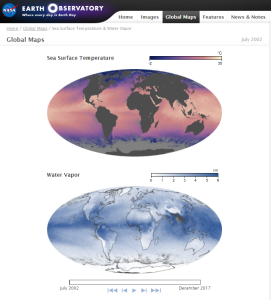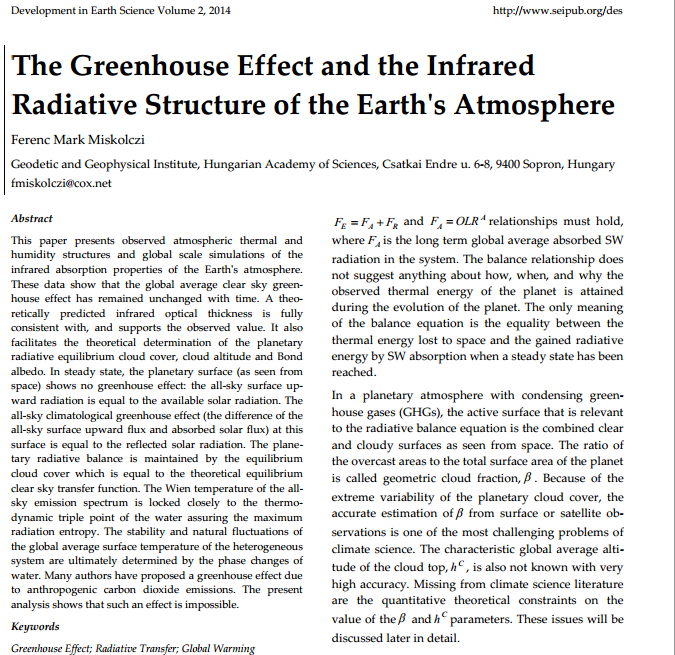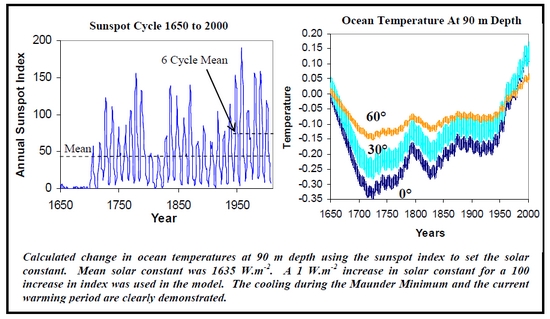Why do we spend our time working on obscure stuff about the way the planets and sun bob about in space? Because changes in solar output are the primary driver of climate change on Earth not changes in the atmosphere. This shown by Miscolczi’s theory which is that the ocean/atmosphere is a self regulating system which maintains an equilibriated and saturated ‘greenhouse effect’. His calculations are backed up by empirical radiosonde data. Some people don’t want you to know that. This letter from Dr Miklos Zagoni in Budapest (one of my favourite cities) gives a clue as to what is now afoot:
Why Dr Ferenc Miskolczi and Dr Miklos Zagoni have been put under pressure to be silent about Miskolczi`s research concerning the atmosphere and the greenhouse effect.
In 2004 Dr Ferenc Miskolczi published a paper ’The greenhouse effect and the spectral decomposition of the clear-sky terrestrial radiation’, in the Quarterly Journal of the Hungarian Meteorological Service (Vol. 108, No. 4, October–December 2004, pp. 209–251.).
The co-author of the article was his boss at NASA (Martin Mlynczak). Mlynczak put his name to the paper but did no work on it. He thought that it was an important paper, but only in a technical way.
When Miskolczi later informed the group at NASA there that he had more important results, they finally understood the whole story, and tried to withhold Miskolczi’s further material from publication. His boss for example, sat at Ferenc’s computer, logged in with Ferenc`s password, and canceled a recently submitted paper from a high-reputation journal as if Ferenc had withdrawn it himself. That was the reason that Ferenc finally resigned from his ($US 90.000 /year) job.
I want to make it clear: NASA never falsified or even tried to falsify Ferenc`s results, on the contrary, they fully understand it. They know that it is correct and see how important it is.
To make sense of their actions, they probably see a national security issue in it. Perhaps they think that AGW is the only way to stop, or to slow, the coal-based growth of China.
In my circumstance where I have been dismissed from my Government paid position in Hungary, I think the information vacuum (in Hungary), has the same type of origin.
I believe someone is in the background trying to convince the establishment (media, science, politics) that Miskolczi’s results are against our national security interests.
First, they tried to frighten me, and then when that did not work, they kicked me out from my job. So now I am turning to the wider internet to publicise Miskolczi`s work, as I know that his results are valid and true. There is no way and no need to hold them back for the world to understand them.
Tomorrow, for the first time in my life, I am jobless.
Budapest, 31 Dec, 2009
Dr Miklos Zagoni
(57)
physicist
Hungary
http://miskolczi.webs.com
I hope everyone joins me in wishing Ferenc and Miklos well for the future.
Zagoni summarizes Miscolczi’s theory here:
http://heliogenic.blogspot.com/2009/12/miklos-zagoni-short-summary-of.html
As you might imagine, the response in the literature to the theory has been deafening silence…











![Ultraviolet image of Venus' clouds [credit: NASA]](https://tallbloke.files.wordpress.com/2016/04/venus_uv1.jpg?w=279&h=300)
![Cloud formation [image credit:NASA]](https://tallbloke.files.wordpress.com/2016/03/nasacloud1.jpg?w=300&h=202)




